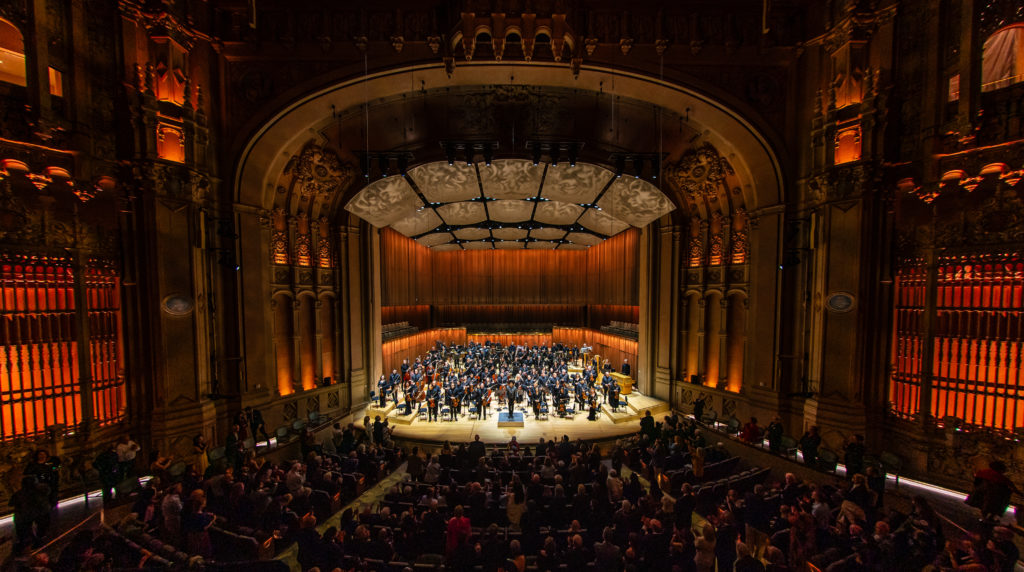The San Diego Symphony and a Host of Virtuoso Soloists Open the Renovated Jacobs Music Center with a Resplendent Concert
Music Director Rafael Payare and the San Diego Symphony opened the newly renovated Jacobs Music Center with a blockbuster concert Saturday. The enthusiastic audience—an appropriately sold-out house for this historic occasion—witnessed a parade of spectacular soloists and the 80-member orchestra put the refurbished and retuned concert hall through its paces.
Stage and screen actor BD Wong narrated this musical cavalcade, giving the audience a Cliff-notes history of the 100-year-old building and how it became part of the orchestra’s even longer San Diego saga. San Diego’s Fox Theater opened as an elegant movie palace at Seventh and B Streets in downtown San Diego in 1929 at the dawn of the Depression, and when the San Diego Symphony acquired the property in 1985 and gave its opening concert a year later on the stage of the aging movie palace, the sonic result proved depressing indeed. I was there, reviewing the concert for the Los Angeles Times San Diego Edition.
Over the years since 1985, the orchestra has made valiant attempts to correct the acoustical deficiencies of a room that was not designed as a concert hall, but none of these measures succeeded. Three years ago the orchestra’s Board of Directors decided that only a complete renovation of the building’s interior, carried out under the acoustical and architectural direction of Akustiks, Inc. and HGA Architects, could turn the movie palace into a first class concert hall.
After hearing Saturday’s concert, I am convinced that the $125 million redesign and reconstruction of the Jacobs Music Center is a triumph both aesthetically and acoustically.
A new hall deserves a new fanfare, so the orchestra commissioned Korean-American composer Texu Kim to write a fanfare for brass and percussion, Welcome Home!!, to open the inaugural concert. Eleven members of the orchestra’s brass sections sounded forth from the new choral balcony that surrounds the orchestra, assisted by four percussionists directly below onstage. Kim’s ebullient wash of fluttering themes expands into a crescendo of overlapping jazzy flourishes in his tightly constructed modernist fanfare. Clarion trumpet calls on top and a persistent percussion pulse below blessed the hall with this stirring sonic initiation.
Soprano Hera Hyesang Park floated two vocal offerings in the of the Jacobs Music Center’s welcoming ambience: Heitor Villa-Lobos’ haunting Aria from his Bachianas Brasilieras No. 5 and the familiar aria from Gioachino Rossini’s opera The Barber of Seville, “Una voce poco fa.” Accompanied by Principal Cello Yao Zhao and seven of his colleagues from the cello section, Park gave the Villa-Lobos Aria an appropriately mysterious, dreamy interpretation, and the hall sustained her most delicate pianissimos. Her ornate flights in the Rossini aria showed the brilliance of her bright coloratura instrument, and the silvery descants of Principal Flute Rose Lombardo sailed through the orchestra with surprising presence.
Tchaikovsky’s Variations on a Roccoco Theme, Op. 33, featuring soloist cellist Alisa Weilerstein gave the first experience of the San Diego Symphony filling the hall with lush Romantic orchestral textures, and the orchestra’s sonority bloomed with rewarding warmth and vibrancy under Music Director Rafael Payare’s adroit leadership. Weilerstein’s account of the composer’s ebullient, demanding solo proved both elegant and yet freshly invigorating. The clarity of the hall’s revised acoustics allowed the audience to more fully appreciate the marvelous detail and finesse of Weilerstein’s playing.To introduce Sergei Rachmaninoff’s Rhapsody on a Theme of Paganini, Op. 4, Concertmaster Jeff Thayer played from the concert hall’s balcony the Paganini Caprice No. 24 in A Minor, on which Rachmaninoff based his piano rhapsody. Following Thayer’s dazzling account of this violin showpiece, Payare and the orchestra immediately launched into the Rachmaninoff with Inon Barnatan as the piano soloist. As Music Director of the La Jolla Music Society’s annual SummerFest, we are accustomed to experiencing Barnatan interpreting complex, probing works of the chamber music repertory, so it was a pleasure to take in his flamboyant and commandingly rambunctious showmanship performing the solo in Rachmaninoff’s Rhapsody. Who but Rachmaninoff would weave the dreary fatalism of the “Dies Irae” chant from the Latin Requiem Mass into his convivial variation cycle? It was clear that both Payare and Barnatan were reveling in the Rachmaninoff, much to the delight of the Jacobs Music Center audience.
Payare’s finale choice wisely focused on displaying the orchestra alone: Maurice Ravel’s Second Suite from his ballet Daphnis et Chloé. Ravel was a supreme orchestrator, and this Suite neglects no section of the orchestra, from the effulgent strings that offer undulating pulses of “Daybreak” to charming wind solos that dance joyfully in “Pantomime,” culminating in a splendid incantation played by Principal Flute Rose Lombardo. Payare’s driving tempo of the closing “General Dance” rallied a series of expansive crescendos that filled the hall with glorious sonorities that amply confirmed the vision of the team that redesigned and revitalized the theater.
The orchestra’s encore: Arturo Márquez’s 2005 Conga del Fuego Nuevo.
This concert was presented by the San Diego Symphony in the Jacobs Music Center on Saturday, September 28, 2024.

Ken Herman, a classically trained pianist and organist, has covered music for the San Diego Union, the Los Angeles Times’ San Diego Edition, and for sandiego.com. He has won numerous awards, including first place for Live Performance and Opera Reviews in the 2017, the 2018, and the 2019 Excellence in Journalism Awards competition held by the San Diego Press Club. A Chicago native, he came to San Diego to pursue a graduate degree and stayed.Read more…



Where was our reviewer seated in the hall?
On the main floor, about 2 rows under the balcony overhang, This is the primary section the acoustical team worked to improve, and I believe they have succeeded. The section is much smaller than before because the rear wall has been moved significantly forward, and the floor of this entire level has been raised.
Reading the review was almost as good as hearing the music!